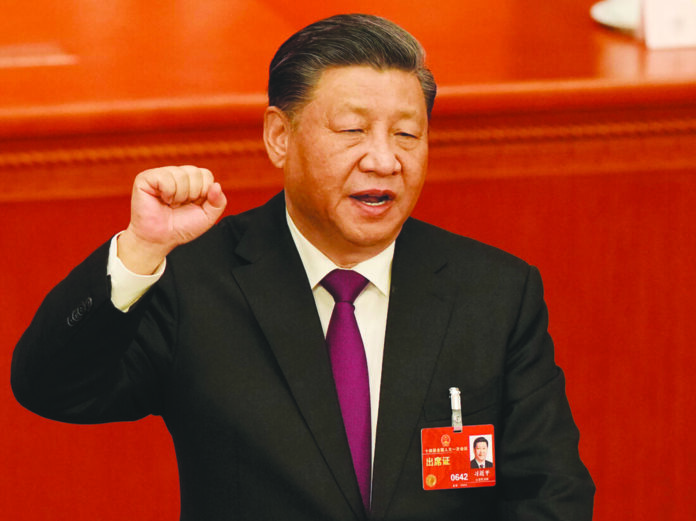China’s leadership signaled a decisive shift toward bolstering economic growth and safeguarding stability in 2025, with key pledges for an expansive fiscal strategy and a moderately accommodative monetary policy.
Meeting on December 9, chaired by President Xi Jinping, the Political Bureau of the Communist Party of China Central Committee outlined its economic and governance priorities. In a landscape fraught with global uncertainty, analysts see this as a calibrated response to stabilize the world’s second-largest economy. The policymakers underscored the need for robust macroeconomic measures to stimulate domestic consumption and drive technological innovation. Their strategy also included stabilizing critical sectors like real estate and financial markets, reflecting a commitment to averting risks and mitigating external shocks.
Apparently, China’s resolve goes beyond traditional frameworks, with promises to expand its policy arsenal, enhance countercyclical tools, and pursue better coordination among various policy levers. By sharpening the focus on targeted, forward-looking regulation, Beijing is seeking not just to recover but to invigorate its economic engine, ensuring resilience and vitality.
This agenda also intertwines with a broader anticorruption campaign, suggesting an integrated approach to governance and economic management. As China enters a critical phase of recalibration, the message is clear: the leadership intends to harness every available instrument to fortify its domestic economic base and navigate an increasingly complex international environment.
China’s pivot toward a “moderately loose monetary policy,” its first such shift in over a decade, signals a bold recalibration aimed at steering the economy through mounting challenges. With potential rate cuts and reduced reserve requirements by the People’s Bank of China, Beijing seems prepared to unleash a suite of measures to reinvigorate growth in 2025. Alongside this, a more assertive fiscal policy hints at prioritizing consumer spending and a recalibration of the beleaguered real estate sector.
At the heart of this strategy lies a reaffirmation of the twin pillars of consumption and investment efficiency. Policymakers emphasized the urgency of broadening domestic demand, a move designed not merely to stabilize but to transform the economy into a more dynamic engine of growth. This transformation hinges, critically, on leveraging scientific and technological innovation to drive new productive capacities and cultivate a modern industrial framework.
Yet the rhetoric of ambition does not stop there. China’s leadership is emphasizing the importance of structural reforms and drastic measures to address entrenched inefficiencies in the economic system. These commitments reflect an acknowledgment that the road to resilience and modernization demands nothing less than a comprehensive overhaul, aimed at reshaping the economic landscape for a precarious global future.
China’s economy appears to be regaining its footing, showing a steady, if cautious, recovery after months of wide-reaching stimulus efforts from Beijing. The manufacturing sector’s official purchasing managers index edged up to 50.3 in November from 50.1 in October, marking its highest point in seven months and remaining safely above the expansion threshold. For a nation grappling with economic headwinds, these incremental gains signal a fragile but noteworthy rebound.
Notably, the December 9 meeting introduced the term “unconventional countercyclical adjustments” to China’s policy lexicon, hinting at a coordinated effort to integrate monetary and fiscal strategies beyond traditional levers like rate cuts. This proactive posture suggests Beijing’s determination to maintain GDP growth at around 5%, steering its economy through global turbulence with a mix of innovation and pragmatism.
The central plank of Beijing’s strategy lies on high-level economic openness. Policymakers are doubling down on stabilizing foreign trade and investment flows, recognizing their importance in driving sustained growth. This isn’t just about maintaining appearances on the global stage – it’s a pragmatic bid to keep the wheels of an export-driven economy turning.
Yet, the ambitions don’t stop at macroeconomics. The Chinese leadership is also stressing the necessity of strong regional strategies, looking to unlock untapped potential across diverse provinces.
Simultaneously, a green agenda is taking center stage, with promises to balance carbon reduction, pollution control, and environmental expansion. China, it seems, is betting on a multipronged approach: steadying its domestic economy while projecting an image of progressiveness. Whether this balancing act succeeds remains to be seen, but the effort is unmistakable. China is leaning into a narrative of resilience and optimism as it charts the course for its economy in 2025. At a December 9 meeting, President Xi Jinping underscored the critical importance of bolstering public confidence, painting a picture of an economy buoyed by untapped potential and inherent resilience. His message was clear: while challenges persist, the fundamental drivers of growth and the economy’s long-term trajectory is firmly intact.
This meeting, held days after a symposium that sought input from non-CPC voices, revealed the Party’s intent to project inclusivity and pragmatism in shaping its economic strategy. The leadership pledged to scale up efforts aimed at improving public well-being, emphasizing a commitment to fostering a stronger sense of gain, happiness, and security among the population. Xi’s remarks carried an unmistakable urgency, calling for collective effort from the Party and society at large to achieve the year’s ambitious economic targets.
The vision he outlined wasn’t just about steadying the ship—it was a rallying cry for renewal, resilience, and hard work. For China, managing the complexities of global turbulence and domestic pressures, this is a high-stakes bid to reaffirm stability and inspire a shared sense of purpose.
China appears poised to embrace unconventional monetary strategies to navigate the mounting uncertainties of 2025, signaling a bold shift in its economic playbook. Observers speculate that measures such as substantial central bank purchases of government bonds and sharper cuts to interest rates and banks’ reserve requirements could form the backbone of this recalibrated approach.
These steps align with policymakers’ growing resolve to inject potency into fiscal and monetary policy, warding off the specter of a sharp economic downturn. The stakes are high. Strengthening fiscal stimulus is seen as pivotal for offsetting external pressures, including persistent tariff threats from the United States.
Experts predict trillions of yuan in additional central government debt may be required to address housing market imbalances and expand social protections. Analysts also foresee cumulative interest rate cuts ranging from 30 to 40 basis points in 2025, with market-driven lending benchmarks potentially witnessing steeper declines.
Notably, the December 9 meeting introduced the term “unconventional countercyclical adjustments” to China’s policy lexicon, hinting at a coordinated effort to integrate monetary and fiscal strategies beyond traditional levers like rate cuts. This proactive posture suggests Beijing’s determination to maintain GDP growth at around 5%, steering its economy through global turbulence with a mix of innovation and pragmatism.























